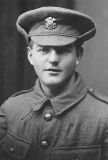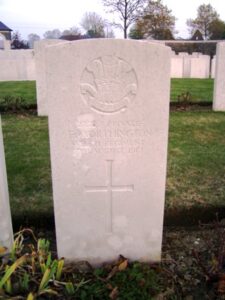The Alexandra Road Boys Council School War Memorial was unveiled in June 1919. It was designed and executed in oak by Mr David John Saer, a native of Cyffig, near Pendine, who was headmaster of the school, and took twelve months to complete. The 48 names of former pupils are carved on revolving squares after the style of the peithynen; an ancient bardic method of writing quatrains. It was unveiled by Dr Abraham Thomas who was medical officer of the Cardiganshire Battery, many of whose members were Aberystwyth men. David died at Aberystwyth on 20 May 1928. The photograph of the memorial is courtesy of Gil Jones, and the portraits of the men come from the collection of Ceredigion Archives.
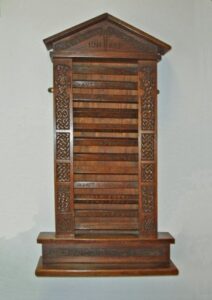
The Great War, 1914-1918
John Frederick Bird, Private, 76348, Royal Army Medical Corps. John was born in 1892, the son of Frederick and Kate Bird, of 7, South Road, Aberystwyth. He enlisted at Aldershot on 25 October 1915 and went to France in June 1916 with the 5th Field Ambulance, Royal Army Medical Corps. The 5th FA was attached to the 2nd Division, and John would have treated many wounded men during the Battle of the Somme that year. In March 1917 the Division followed the German Retreat to the Hindenburg Line, and in April they fought at Arras, during the First Battle of the Scarpe, the Battle of Arleux and the Third Battle of the Scarpe. Their next major action was at the Battle of Cambrai. The Division was still in the area when John was killed in action on 18 February 1918. He was 25 years old, and is buried in the British Extension of Metz-en-Couture Communal Cemetery, France.
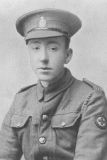
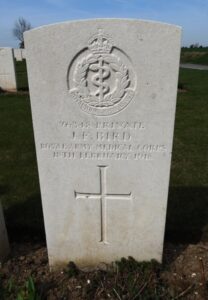
Samuel Bluck, Gunner, 102692, Royal Garrison Artillery. Sam was born in 1885, the son of Samuel and Emma Bluck, of Cross Foxes, Mill Street, Aberystwyth. He enlisted at Aberystwyth on 10 December 1915 into the Royal Artillery, and was posted to France with the 172nd Siege Battery on 25 July 1916. By November, Samuel had returned home sick, and after recovering was sent back out to France, joining the 321st Siege Battery, Royal Garrison Artillery in June 1917. The Battery was at Ypres, and was firing preliminary ‘softening-up’ bombardments on the German lines when Samuel was killed by a shell splinter on 25 June 1917. He was 32 years old, and is buried in Vlamertinghe New Military Cemetery, Belgium.
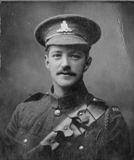
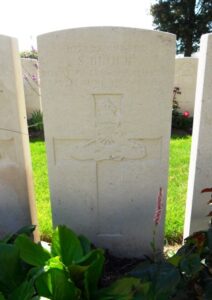
Robert Arthur Buttery, Second Lieutenant, Oxford and Bucks Light Infantry. Robert was the son of Robert William Buttery, and of Amy Caroline Buttery, of London. He was educated at Aberystwyth and was commissioned from the OTC into the 1st Battalion, Ox and Bucks Light Infantry on 19 December 1916. Robert was then posted to the 1/4th Battalion, Ox and Bucks Light Infantry, which was attached to 145 Brigade, 48th (South Midland) Division. In March 1917 the division followed the German Retreat to the Hindenburg Line, and later in the year fought at Third Ypres. The Division was ordered to Italy on 21 November 1917, remaining there for the duration of the war. Robert was killed in Italy on 15 June 1918. He was 27 years old, and is buried in Boscon British Cemetery, Italy.
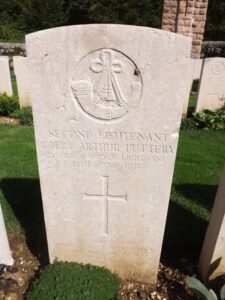
Robert Corfield, Gunner, Royal Field Artillery. Robert was born in 1887, the son of Elizabeth Corfield of 43 North Parade, Aberystwyth. He was a hairdresser prior to the war, and was a pre-war Territorial with the Cardigan Battery, Royal Garrison Artillery. Robert was mobilised at the outbreak of war, and moved with the Battery to Bedford. On 26 August 1915, the Battery was on manoeuvres when Robert fainted whilst sat on a gun carriage, and fell backwards, under the wheels. He received a broken jaw and depression to the back of the head, which killed him instantly. Robert was 27 years old, and was buried with full military honours in Aberystwyth Municipal Cemetery. Following research by myself, Robert’s case was submitted to the CWGC on 5 August 2012. On Friday 7 February 2014, Robert was finally accepted for commemoration by the CWGC.
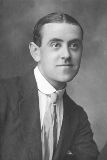
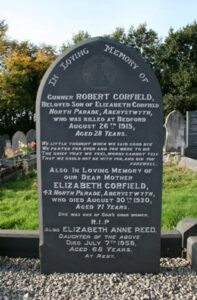
David John Brutus Davies, Bombardier, 86740, Canadian Field Artillery. David, better known to his Aberystwyth friends as Brutus, was born on 27 March 1887, the son of Hannah Davies and was educated at the County School in Aberystwyth before serving as an apprentice fitter and turner at the Rheidol Foundry. In 1910 he emigrated to Canada where he settled in Saskatchewan with his wife Ada. A former territorial with the Cardigan Battery he enlisted at Winnipeg on 29 December 1914 into the 5th Brigade, Canadian Field Artillery. The battery moved to France in the spring of 1915, and took up positions at Ypres. The Canadians took part in several major actions during 1915, and after another engagement at Mount Sorrel in June 1916 moved to the Somme. Here the Canadians fought at the battle of Flers-Courcelette, and the ensuing Battle of Thiepval. On 3 November 1916, Brutus, along with thirteen men of his company, were at sleep in a trench near Pozières, when they were killed in their sleep by a German shell. David was 29 years old, and is buried in Pozières British Cemetery, France.
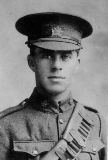
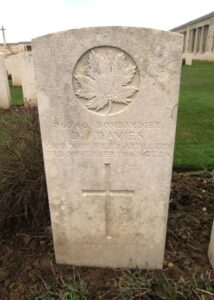
David Rees Davies, Sergeant, 14400, Kings Shropshire Light Infantry. David was the son of Aberystwyth Councillor David Davies, and of Eliza Jane Davies, and was employed at Lloyds Bank. He played football for Aberystwyth Town FC at centre forward. David joined the 7th Battalion, Kings Shropshire Light Infantry along with his close friend Edward David Evans on the same day in September 1914. The battalion was attached to 76 Brigade, 25th Division, and landed at Boulogne on 28 September 1915. On 15 October 1915 the Brigade moved to the 3rd Division, and on 19 October 1915 the battalion transferred to 8 Brigade in the same Division. In 1915 the Division saw action at Bellewaarde and Hooge, and took part in the Second attack on Bellewaarde. In 1916 the Division fought at the Actions of the Bluff, and at the St Eloi Craters. On 1 May 1916 David had volunteered to take up a forward position in the front line at Dickebusch. Sadly, the position was hit by shellfire, mortally wounding David. He died of his wounds that same day, before he could be taken to a dressing station. David was 23 years old, and is buried in La Clytte Military Cemetery, Belgium.
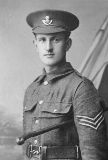
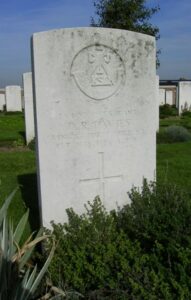
Gwilym Mansel Pritchard Davies, Rifleman, A/204035, London Regiment. Gwilym was the only son of Thomas Rhys Davies and Mag Hopkins Davies, of The Tonn, Llanon, Cardiganshire. The family later moved to Bryn Derwen, Llangadock. Gwilym was educated at Bristol and Aberystwyth Universities, and served for a time as a Certificated Teacher. He enlisted at Neath into the 12th Battalion (The Rangers), the London Regiment, which moved to France in December, 1914. On 8 February 1915 they joined 84 Brigade, 28th Division, and fought at Second Ypres. On 12 February 1916 they moved to become part of 168 Brigade, 56th Division, and fought at Gommecourt, and the Somme Battles of 1916. The Division followed the German withdrawal to the Hindenburg Line in March, 1917 before fighting at the Scarpe during the Arras Offensive. They then fought at Third Ypres and Cambrai, and on 31 January 1918 transferred to 175 Brigade, 58th Division and met the German Spring Offensive in the St. Quentin sector. The Division remained in the area, fighting during the Battles of Villers-Brettoneux and Amiens, when the German offensive was halted. Gwilym was wounded around this period, and Died of Wounds on 24 August 1918, aged 29. He is remembered on the Vis-En-Artois Memorial, France.
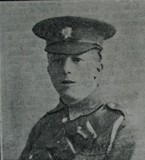
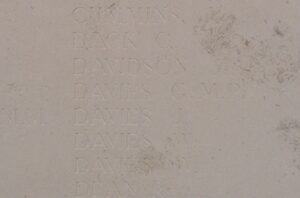
David Henry Doughton, Corporal, 40748, Canadian Field Artillery. David was born at Liverpool on 16 August 1884, the son of David and Elizabeth Doughton. His parents were from Aberystwyth, and had moved the family back there at some time after 1901. David married Elizabeth Alice Hughes in 1907, and in 1912 the couple migrated to Canada with David’s parents, setting up home at Smith’s Falls, Ontario, where David worked as a Carpenter. On 19 August 1914 David enlisted at Valcartier into the 1st Brigade, Canadian Field Artillery, and in late 1914 visited relatives in Aberystwyth after the Canadians had arrived in the UK. The first action of the Canadians was in the Second Battle of Ypres when, in a letter home, David described how on the 25 April 1915 he witnessed the first German gas attack on the French Algerians at s’Gravenstafel. David’s Division remained in the Ypres area until the summer of 1916 before going to the Somme, where it fought at Courcelette and Regina Trench. The following year David took part in the Battle of Vimy Ridge. Later that year the Division was back at Ypres, where the Canadians captured Passchendaele village. It was here, on 21 November 1917 that David was killed in action. He was 33 years old, and is buried at Vlamertinghe New Military Cemetery, Belgium.
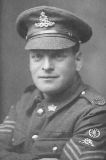
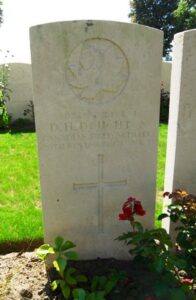
Alfred Thomas Edwards, Private, 27022, Royal Welsh Fusiliers. Alfred was the son of John and Mary Edwards, of 10, Little Darkgate Street, Aberystwyth. He enlisted at Holborn, London into the Royal Welsh Fusiliers, and was posted to France early in 1916, joining the 1st Battalion, Royal Welsh Fusiliers, which was attached to 22 Brigade, 7th Division. The battalion was on the Somme, stationed near Fricourt, where two of its officers included Robert Graves and Siegfried Sassoon, two of the most famous war poets. The battalion took part in the 1 July 1916 assault at Fricourt towards Mametz Village; one of the few successes of the opening day of the battle. After the 38th Division had captured Mametz Wood, the 7th Division moved past towards High Wood. Alfred was killed at High Wood on 3 August 1916. He was 24 years old, and is commemorated on the Thiepval Memorial, France.
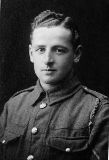
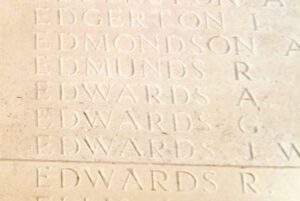
David James Edwards, Gunner, 190346, Royal Field Artillery. David was born in Aberystwyth in 1883, the son of Evan and Anna Marie Edwards of 48, Cambria Street, Aberystwyth. Sometime before the start of the War, David had met and married Elizabeth Roberts, the daughter of Thomas and Mary Roberts, of Lower Gosport Street, Laugharne. In 1916, David was called up and became a Gunner in ‘A’ Battery, 296th Brigade, Royal Field Artillery, which was attached to the 59th (Second North Midland) Division. In April 1916, the Division moved to Ireland to help quell the Republican uprisings that were gathering momentum at the time, and took part in the fighting of the Easter uprising. In January 1917 the Division returned to England, before heading to France in February, moving to Ypres. David was part of the crew of a Gun Battery that took part in the shelling of the German Lines which marked the beginning of the Battle of the Menin Road, on 20 September 1917. After weeks of heavy fighting, the artillery was slowly moved forward, keeping pace with the slow advance of the infantry. David was wounded at the Battle of Polygon Wood, and was brought back to the Casualty Clearing Station at Dozinghem, where he died of his wounds on 29 September 1917, aged 33.
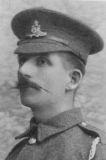
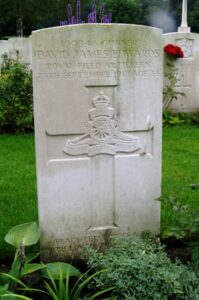
John Humphrey Edwards, Private, 19958, Royal Fusiliers. John was the son of John Humphrey Edwards and Mary Edwards, of Arlwyn, Llanbadarn Road, Aberystwyth. He enlisted at Chester into the 26th (Bankers) Battalion, Royal Fusiliers, which was attached to 124 Brigade, 41st Division. The Division moved to France by 6 May 1916, and began trench familiarisation in the Ploegsteert sector, south of Ypres. They remained here until August 1916, when they moved to the Somme, and took part in the Battle of Flers-Courcelette. The Division remained in the line, pushing on to Courcelette over the next few days before coming out for a rest and re-fit. They then fought at the Battle of Le Transloy, before moving to positions south of Ypres in 1917. John was on guard duty at a junction in the trench on 1 May 1917, when a shell exploded nearby causing severe wounds from which he died that same day. He was 26 years of age and is buried at Dickebusch New Military Cemetery, Belgium.
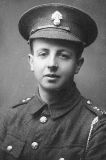
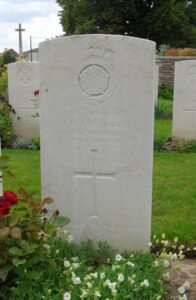
John Richard Edwards, Private, 53766, Cheshire Regiment. John was born in 1899, the son of Robert Edwards, of 4, Powell Street, Aberystwyth. He enlisted on 2 March 1916 at Brecon into the Training Reserve Battalion, and was posted to France on 30 May 1918, joining the 1st Battalion, Cheshire Regiment, which was attached to 15 Brigade, 5th Division. On 14 August 1918, 5th Division was in GHQ Reserve, and two weeks later began its part in the famous advance to victory. The Division took part in the advance from Albert towards the Hindenburg Line, fighting through Irles, Beugny, Havrincourt, Gonnelieu and the River Selle, and finally into Valenciennes and the River Sambre. John was killed in action after being struck by shrapnel in an attack on a village on 23 October 1918. He was 18 years old, and is commemorated on the Vis-En-Artois Memorial, France.
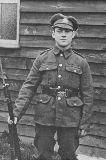
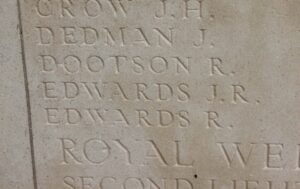
William John Edwards, Gunner, 168353, Royal Field Artillery. William was the son of David and Ann Edwards, of 9, Spring Gardens, Aberystwyth. He left Aberystwyth with the Cardigan Battery, Royal Field Artillery in August 1914, but didn’t get posted to France until 1916, after being transferred to the 124th Battery, 28th Brigade, Royal Field Artillery, which was attached to the 5th Division. William probably fought at the Battle of the Somme that year, and moved with the Division to Ypres the following year, where they took part in the Third Battle of Ypres. William was killed in action at Ypres on 5 August 1917, aged 23 and is buried in The Huts Cemetery, Belgium. In his last letter home he said that he had been recommended for the Meritorious Service Medal, but this was not a posthumous award, and so its award was never forthcoming.
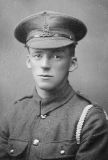
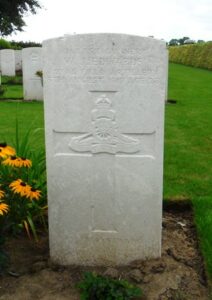
Anwyl Ellis, Lieutenant, Royal Naval Volunteer Reserve. Anwyl was the son of David and Catherine Ellis of Aberystwyth. He had played football for Aberystwyth FC, prior to becoming professor of navigation at Glasgow University, and was a Royal Naval Reservist. At the outbreak of war, Anwyl was mobilised, joining the Motor Boat Reserve, and served aboard the Lady Lel. Anwyl became the first Aberystwyth casualty of the Great War when he was drowned when Lady Lel was lost in Loch Ewe on 18 November 1914. He was 36 years old, and is buried at Poolewe Old Burial Ground, Scotland. His brother, Ceredig, died later in the war.
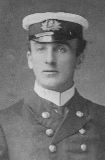
Ceredig Ellis, Second Lieutenant, Royal Welsh Fusiliers. Ceredig was the youngest son of David and Catherine Ellis, of Aberystwyth. Ceredig was a partner in a millinery and drapery business at Aberystwyth prior to the war, and had played football for Aberystwyth FC. He enlisted into the 15th Battalion, Royal Welsh Fusiliers, and whilst training at Colwyn Bay, met and married Mildred Cavanagh at Conwy in 1915, just prior to the battalions move to Winchester. The battalion was attached to 113 Brigade, 38th (Welsh) Division. On 4 December 1915 the battalion moved to France, and the entire Division moved to the Fleurbaix sector, where it was initiated into trench warfare. Ceredig had been commissioned as Second Lieutenant in the meantime, and joined the battalion at Cuinchy on 29 March 1916. During June 1916 the Division marched south to the Somme, and on 7 July 1916 attacked Mametz Wood. The initial attack failed, and it was three days later, on 10 July, that a fresh attack was mounted. Ceredig was wounded during the terrible fighting within the wood, and was evacuated to Abbeville, where he died of his wounds on 19 July 1916, aged 34. Ceredig is buried at Abbeville Communal Cemetery, France.
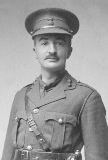
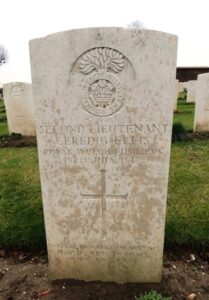
Edward David Evans, Company Sergeant Major, 14401, Kings Shropshire Light Infantry. Ted was born in 1887, the son of Edward and Elizabeth Evans, of 15, Baker Street, Aberystwyth. Prior to the outbreak of war he had worked at the L C & M Bank in Newcastle Emlyn. He enlisted at Carmarthen into the 7th Battalion, Kings Shropshire Light Infantry in September 1914 along with his close friend David Rees Davies. On 28 September 1915 the Battalion landed at Boulogne, joining 8 Brigade, 3rd Division at Meteren. The Division then moved to the Ploegsteert Wood sector, before moving to the Busseboom Sector at Ypres. The 7th KSLI took up positions in Sanctuary Wood, and fought at the Actions of the Bluff, and at the St Eloi Craters. The Division was then moved south to the Somme, and fought there at the Battle of Albert. During an assault on the German trenches at Bazentin Ridge on 14 July 1916, Ted’s company was caught on barbed wire and came under heavy fire from enemy machine guns. Ted was killed in action that day, and is commemorated on the Thiepval Memorial, France. He had severely felt the death of his old friend Sergeant David Rees Davies, of Aberystwyth, who had enlisted at the same time and had been killed a few weeks earlier.
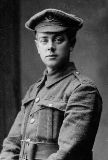
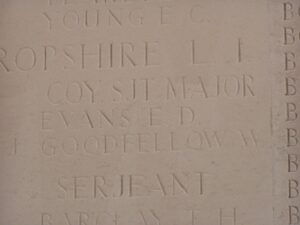
Frederick George Evans, Seaman, 2127/D, Royal Naval Reserve. Fred was born at Aberystwyth in 1877, the son of Frederick George Evans and Annie Evans. He married in 1903, and resided with his wife, Susannah Evans, at 8, Poplar Row, Aberystwyth. Fred worked as a Boatman prior to the war, and was a member of the local Royal Naval Reserve in Aberystwyth. He left the town for Devonport on 4 August 1914 along with a number of other local men, who went on the serve on HMS Caesar. Fred took ill at Devonport, and on 15 February 1915 was discharged while serving with HMS Vivid and returned home due to ill health. He died at Aberystwyth Infirmary on 23 June 1915, aged 38. Fred was buried in Aberystwyth Municipal Cemetery with full military honours.
David Henry Felix, Private, 33024, Welsh Regiment. David was the son of David and Margaret Felix, 4, Edge Hill Road, Aberystwyth. A loyal member of Tabernacle Chapel, he was educated at Alexandra Road School. David enlisted at Pontypridd into the Welsh Regiment, and was posted to France on 22 June 1915, joining the 1st Battalion, Welsh Regiment, which was attached to 84 Brigade, 28th Division. David joined the battalion during the tail end of the Second Battle of Ypres, and was posted to D Company. The battalion was stationed in the Locre area when David was killed in action on 9 August 1915. He was 19 years old, and is buried at Kemmel Chateau Military Cemetery, Belgium.
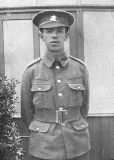
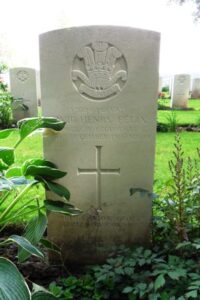
William Henry Harries, Private, 10789, South Wales Borderers. William, known locally as Willie, was born at Aberystwyth, and enlisted at Brecon into the 2nd Battalion, South Wales Borderers. The battalion was stationed at Tientsin, China at the outbreak of war, and on 23 September 1914 landed at Lao Shan Bay for operations against the German territory of Tsingtao. On 4 December 1914 the battalion embarked at Hong Kong, landing at Plymouth 12 January 1915, and became attached to 87 Brigade, 29th Division. On 17 March 1915 the Division embarked at Avonmouth for operations at Gallipoli, landing at Cape Helles on 25 April 1915. The Brigade landed at “S” Beach, Morto Bay that day, and took their position with few casualties. William had been wounded at some time, and had returned to Britain, but upon recovering embarked at Avonmouth for Gallipoli aboard HMT Royal Edward. She was sailing for the island of Lemnos, a staging point for the Gallipoli peninsular with Willie aboard, but was spotted by the German submarine UB-14 in the Aegean Sea, and torpedoed, sinking within six minutes, with the loss of 935 lives. Willie was drowned on 13 August 1915 and is commemorated on the Helles Memorial, Gallipoli.
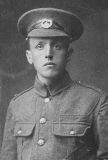
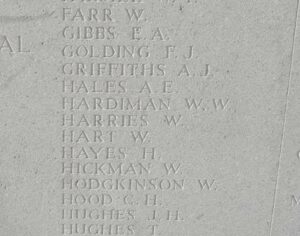
James John Herbert Howard, Lance Corporal, 19963, Royal Welsh Fusiliers. James was born in 1892, the son of Margaret Howard, of Mill Street, Aberystwyth. He was a faithful member of Tabernacle Chapel Sunday School and played football for Aberystwyth Town FC prior to the war. James originally enlisted at Aberystwyth into the 9th Welsh, but transferred to the 16th Battalion, Royal Welsh Fusiliers, which was attached to 113 Brigade, 38th (Welsh) Division. The Division had landed in France during December 1915 and had spent their first winter in the trenches near Armentieres. In June they marched south to the Somme, where they were tasked with the capture of Mametz Wood. The attack on the wood began on 7 July, but met with fierce resistance, and it took until 14 July to totally clear the wood. James suffered serious injuries to his leg and arm when a shell exploded near to him during the assault on Mametz Wood. Capt G D Ellis, his senior officer in the 16th RWF informed his parents that “there was little room to hope that he would recover”. James died on 12 July 1916, aged 23, and was buried in Carnoy Military Cemetery, France.

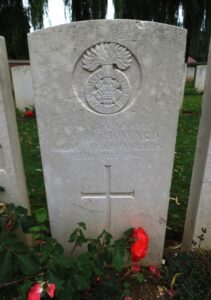
Llewellyn Hughes, Wireless Operator, Mercantile Marine. Llew was born in 1890, the son of Mrs Mary Hughes of Moel-y-Don, Prospect Street, Aberystwyth. He served in the Mercantile Marine. Llewellyn had a busy war. On 4 November 1915 he was hospitalised when his ship, the troopship Mercian, suffered damage when intercepted and shelled by the German submarine U-38. Upon recovering, Llewellyn became a Wireless Operator aboard the SS Eloby, a Liverpool registered steamer. On 19 July 1917, Eloby was on route to Alexandria, with a cargo of explosives, when she was torpedoed and sunk in the Mediterranean by the German submarine U-38, with the loss of 156 lives. Llewellyn was 27 years old when he died that day, and is commemorated on the Tower Hill Memorial, London.
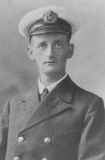
Thomas William James, First Engineer, Mercantile Marine. Thomas was the son of David and Mary Jane James (nee Rees), of 11, Sea View Place, Aberystwyth. He served with the Mercantile Marine as First Engineer on the SS Kildonan, a Cardiff registered steamer. On 26 October 1917, Kildonan was carrying a cargo of ore when she was torpedoed and sunk by the German submarine U-35. Thomas was 26 years old when he died that day, and is commemorated on the Tower Hill Memorial, London.

John Hugh Joel, Private, 37458, Machine Gun Company. John was born in 1883, the son of Abraham and Elizabeth Joel, of Green Gardens, Aberystwyth. He resided at Llanwonno prior to the war, and in March 1916 enlisted at Tredegar into the Royal Welsh Fusiliers. John was later transferred into the 4th Company, Machine Gun Corps, which was attached to the 16th (Irish) Division. John’s machine gun team was in action at Ypres when he was struck by a shell splinter and killed on 16 August 1917, aged 34. He was buried in a small cemetery near Ypres, but his grave was subsequently lost during further fighting in the area, and he is now commemorated on the Tyne Cot Memorial, Belgium.
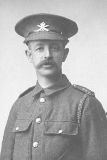
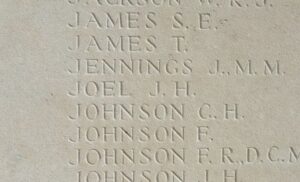
David Jones, First Engineer, Mercantile Marine. David, known locally as Dei, was the son of Captain Richard David Jones and Mary Jones, of Ael-y-Bryn, Talybont. He served with the Mercantile Marine as First Engineer aboard the SS Argyle, a Newport registered steamer. On 13 April 1917, Argyle was on route from Port Kelah for Middlesbrough with a cargo of iron ore, when she was torpedoed and sunk by the German submarine U-84, off Harwich, with the loss of 22 lives. David was 28 years old when he died that day, and is commemorated on the Tower Hill Memorial, London.
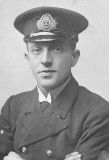
David John Jones, Able Seaman, J/21319, Royal Navy. David was the son of David Jones, of Holmhurst, 5, Rheidol Terrace, Penparcau, Aberystwyth. David served with the Royal Navy aboard HMS Q7, a Q ship, which was an armed merchant ship, with concealed weaponry, designed to counter the U boat threat. David was 20 years of age when he drowned as his ship was sunk on 13 March 1917. He is commemorated on the Plymouth Naval Memorial, Devon.
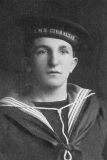
Edwin Griffiths Jones, Private, 22360, Royal Welsh Fusiliers. Edwin was born in 1884, the son of John and Susannah Jones, of Aberystwyth, and after graduating from the university in 1911 taught Geography at the County School. Prior to the war he resided with his wife, Lily Jones, at 2, Llican Terrace, Great Orme, Llandudno. He enlisted at Aberystwyth into the 15th Battalion, Royal Welsh Fusiliers. The battalion was attached to 113 Brigade, 38th (Welsh) Division, and landed in France on 2 December 1915, moving to the Fleurbaix sector, where it was initiated into trench warfare. On 7 May 1916, a party of the 15th RWF was detailed to raid the German trenches at Fauqissart, and that night the men, armed with clubs, knives and rifles, crossed No Man’s Land into the German lines, killing around 50 Germans, and capturing several prisoners. Edwin was wounded during the raid, and was helped back to the Welshmen’s lines. He was evacuated to Hospital at Merville where he died on 8 May 1916. Edwin is buried at Merville Communal Cemetery, France.
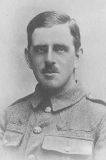
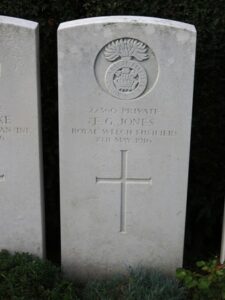
Frederick Robert Jones. Fred was born in Portland Street, Aberystwyth in 1885 and was the only son of Mr and Mrs Peter Jones JP. He was educated at Alexander Road School and Aberystwyth County School. On leaving school Fred served his engineering apprenticeship in Green’s Foundry, Aberystwyth before taking up a employment at Metcalfe’s engineering works in Manchester and the Great Western railway works in Swindon. To progress his career he left for Canada in March 1912 and was employed in construction work on the Canadian Northern and Canadian Pacific Railways. Realising the urgent need for his engineering skills for the war effort he decided in 1915 to return home on the first available boat and offer his engineering skills in the armaments industry. Frederick booked second cabin passage on the RMS Lusitania from New York to Liverpool. The liner left New York on the 1 May and six days out, on the afternoon of 7 May, the Lusitania was torpedoed by the German submarine U-20, twelve miles off the Old Head of Kinsale in southern Ireland. She sank within twenty minutes. No trace of his body was ever found. He was 30 years of age. Though not in the armed forces, Frederick Jones is commemorated on three war memorials in Aberystwyth: Aberystwyth County School, Alexander Road School and Bethel Chapel.
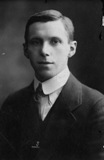
John Arthur Jones, Private, 22445, Somerset Light Infantry. John was the son of John and Margaret Jones of 2, Powell Street, Aberystwyth. He was a journalist prior to the war, and resided at Bow Street, Longport, Somerset. John enlisted at Taunton into the 8th Battalion, Somerset Light Infantry. On 10 September 1915 the battalion landed at Le Havre, attached to 63 Brigade, 21st Division, and in July 1916 fought at the Battle of Albert. On 8 July 1916, 63 Brigade, transferred to the 37th Division on the Somme. The Division then moved to Arras, and took part in the First Battle of the Scarpe, where they captured Monchy le Preux. They then took part in the Second Battle of the Scarpe, and the Battle of Arleux before moving north to Ypres. Here, they fought throughout Third Ypres. John was killed at Ypres on 31 July 1917. He was 28 years old, and is commemorated on the Ypres (Menin Gate) Memorial, Belgium.
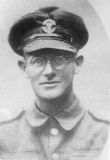
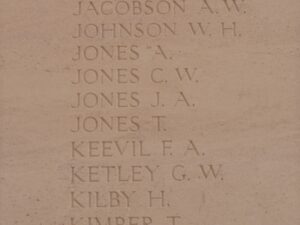
John Benjamin Stanley Jones, Private, 60581, Cheshire Regiment. John was born at Aberystwyth in 1899, the son of William and Catherine Jones, of 3, Sheldon Court, Aberystwyth. By 1911 the family had moved to Price Town, near Nantymoel, where William worked as a stone mason. John enlisted at Bridgend into the army, and was posted to France, probably in the spring of 1918, joining the 1st Battalion, Cheshire Regiment, which was attached to 15 Brigade, 5th Division. The division had been hurriedly recalled to France from Italy following the German offensive of 21 March 1918, and moved to positions in Northern France, in the Lys Valley. The division then took part in the defence of Nieppe Forest. John was killed in action near Thiennes on 28 June 1918. He was 19 years old, and is buried in Tannay British Cemetery, Thiennes, France. This man is shown on the memorial just as John Jones, but is most likely the correct person.
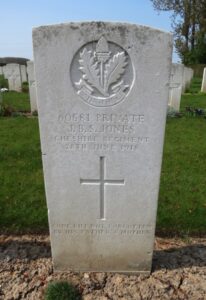
John James Jones, Driver, 243868, Royal Field Artillery. John was born in 1894, the son of Jane Jones, of Brynteg, Custom House Street, Aberystwyth. He served on the Western Front as a Driver with the Royal Field Artillery. John took ill towards the end of the war and died of influenza at Ripon Military Hospital on 18 November 1918, aged 24. He was buried in Blaenplwyf Calvinistic Methodist Chapelyard, Blaenplwyf, Aberystwyth.
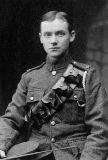
Robert Jones, Guardsman, 1237, Welsh Guards. Robert was born in Aberystwyth in 1880, the son of John and Eleanor Jones. He enlisted at Aberdare into the 1st Battalion, Welsh Guards. The Regiment was raised by Royal Warrant of 26 February 1915, at White City, before landing at Le Havre on 18 August 1915, becoming attached to 3rd Guards Brigade, Guards Division. The Division saw its first major action during the Battle of Loos on 25 September 1915, remaining in the area during the coming months, where they also fought in the subsequent Action of Hohenzollern Redoubt. In July 1916 the Division moved to the Somme, where they fought at the Battle of Flers-Courcelette, and then at the Battle of Morval, capturing Lesboeufs Village. They remained here for the winter, and it was during this dismal period of the war that Robert was wounded. He died of wounds on 1 January 1917, aged 37 and is buried in Grove Town Cemetery, Méaulte, France.
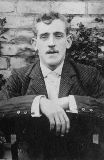
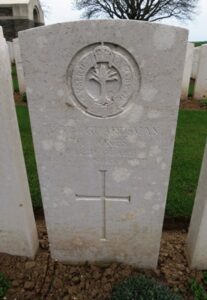
Thomas David Jones, Rifleman, R/4270, King’s Royal Rifle Corps. Thomas was born at Miles Platting, Lancashire in 1883, the son of Mary Jones. He was brought up in Aberystwyth, and had served for six months with the 1st Cardigan Volunteer Artillery in 1902. Thomas enlisted on 13 September 1914 at St. Paul’s Churchyard, London, into the King’s Royal Rifle Corps. On 8 October 1914 Thomas was posted to the 13th Battalion, King’s Royal Rifle Corps. The battalion moved to Windmill Hill, Salisbury Plain in April 1915, joining 111 Brigade, 37th Division, before landing at Boulogne on 31 July 1915. The division concentrated near Tilques, before moving into positions on the Somme, where it saw its first major action on 1 July 1916 at the Battle of Albert. On 4 August 1916, Thomas was admitted to the 2nd Field Ambulance, suffering from multiple gunshot wounds, which he’d suffered during an attack on the Somme that day. Thomas died of his wounds on 8 August 1916, aged 32. He is buried in Bois Guillame Communal Cemetery, France.
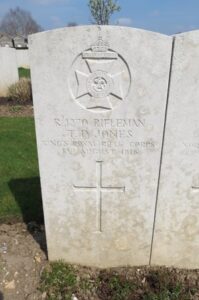
Thomas Owen Jones, Seaman, 4056A, Royal Naval Reserve. Tommy was a member of the Royal Naval Reserve in Aberystwyth and on 4 August 1914 he and his fellow reservists entrained for Devonport. Tommy was one of fifteen men from the town who served on HMS Jupiter which saw service in the White Sea during February and March of 1915. Her task was to ensure the passage to Archangel, Russia was kept clear of ice so that supplies for the Russian Army could continue to flow. In recognition of their service the Emperor of Russia, Tzar Nicholas II, conferred on the officers and men the Russian Medal for Zeal. On his return to Aberystwyth Tommy was transferred to the mine sweeper HMPMS Nepaulin. She was the Clyde paddle steamer Neptune converted for mine sweeping duties with the Dover Patrol because of her shallow draft. On 20 April 1917 she struck a mine off the Dutch coast and sank taking eighteen crew to the bottom. Tommy was at the wheel at the time of his death and is commemorated on the Plymouth Naval Memorial. He left a wife and young child.
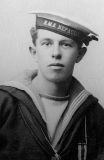
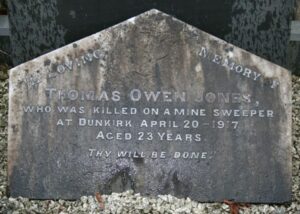
John David Lewis, Gunner, 88713, Royal Field Artillery. John was the son of David and Mary Lewis, of 62, Clydach Road, Blaenclydach. He resided at Brynglas, Chancery, Aberystwyth with his brother, Daniel prior to the war. John enlisted into the Royal Artillery, and landed in France on 20 May 1915 attached to C Battery, 50th Brigade, Royal Field Artillery, which was attached to the 9th (Scottish) Division. The Division saw its first major action during the Battle of Loos in September 1915. During 1916 the Division saw much fighting throughout the Battle of the Somme, and in 1917 fought at the Battle of Arras and at the Third Battle of Ypres. In November 1917 the Division moved to Cambrai, and fought at the Action of Welsh Ridge. In March 1918 the Division was still in the Cambrai area, and was one of the Divisions hit there by the German Spring Offensive, fighting at the Battle of St Quentin, and the First Battle of Bapaume. After suffering terrible casualties the Division were moved to Flanders to rebuild, but the Germans launched another offensive there during April 1918, and the Division then took part in the Battles of the Lys. From August 1918 the Division took part in the Advance in Flanders, where they took part in the Action of Outtersteene Ridge, fighting in the subsequent Battle of Ypres. John was wounded during the great offensive, and was evacuated to the military hospital at Wimille, where he died of his wounds on 29 October 1918, aged 25. John is buried at Terlincthun British Cemetery, Wimille, France. His brother Daniel also fell.
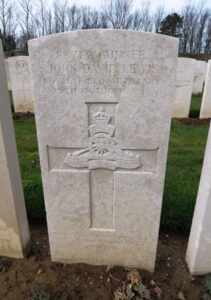
Trefor Lewis, Private, 77027, Royal Army Medical Corps. Trefor was the son of James and Elizabeth Lewis of Willows, 27, Portland Street, Aberystwyth. He was employed on the clerical staff of the National Library of Wales and a member of St Paul’s Chapel, prior to enlisting into the Royal Army Medical Corps. Trefor was posted to the 5th Field Ambulance, Royal Army Medical Corps, which was attached to the 2nd Division. The Division had been in France since the outbreak of war, and had fought in the retreat from Mons to the Marne. The 2nd Division was then moved to Flanders, and fought at the First Battle of Ypres, when the German sweep through Flanders was stopped, remaining there throughout the first winter of the war. In 1915 they took part in the Battle of Festubert, and in September fought at the Battle of Loos, and subsequent Action of Hohenzollern Redoubt. In the summer of 1916 the Division was on the Somme, and took part in the Battle of Delville Wood. Trefor was wounded here on the 8 August 1916. He was repatriated back to the UK and admitted into Hampstead Hospital where he died on 20 August 1916, aged 20. Trefor was buried with full military honours in Aberystwyth Cemetery.
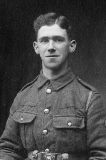
Albert E. Lloyd. This man cannot presently be identified.
Richard William Millman, Gunner, 168400, Royal Field Artillery. Richard was born on 1 September 1892, the son of Henry and Sarah J. Millman, of 3, Harbour Terrace, Trefechan, Aberystwyth. Richard worked for the Great Western Railway prior to the war, and was a pre-war territorial, reporting for duty with the Cardigan Battery, Royal Field Artillery on 5 August 1914. Richard was posted to the Guards Trench Mortar Battery, Royal Field Artillery, which was attached to the Guards Division. The Guards Division had had a hard war. It fought at Loos in September 1915, and in 1916 fought at the Somme. In 1917 the Guards fought at Third Ypres, and at the Battle of Cambrai. During 1918 the Division had fought against the German offensive on the Somme, and later that year took part in the great advance to victory, ending up at Maubeuge at the Armistice. Richard survived the war, but died of influenza on 6 December 1918 at the 4th Casualty Clearing Station. He was 26 years old, and is buried in Solesmes British Cemetery, France.
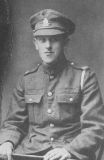
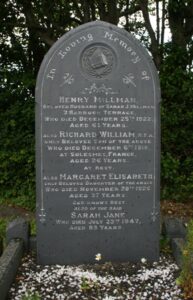
Joel William Morris, Gunner, W/1386, Royal Field Artillery. Joel was born in 1890, the son of Rees and Sarah Morris, of Rose Cottage, Queens Street, Aberystwyth. He worked at Brynamman, and enlisted at nearby Ammanford into the Royal Field Artillery, serving in their ‘B’ Battery, 122nd Brigade, attached to the 38th (Welsh) Division. By 5 December 1915, the Division had disembarked at Boulogne, and during the winter and spring of 1916 held the line in French Flanders, before moving south to the Somme, where they fought at Mametz Wood. After a year in reserve, they fought at Pilckem Ridge and Langemarck, during the Third Battle of Third Ypres. Joel was killed in action during the Battle of Langemarck on 14 August 1917. He was 24 years old, and is buried in Canada Farm Cemetery, Belgium.
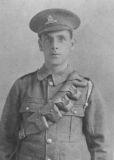
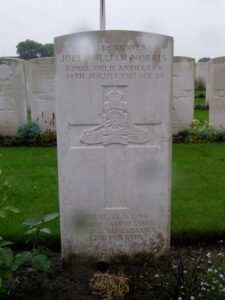
John Frederick Parry, Lance Corporal, 32518, Welsh Regiment. John was born in Capel Bangor, the son of David Griffith Parry and Elizabeth Parry, of Neuadd Villa, Taliesin, Glandyfi, Cardiganshire. Prior to the war the family had moved to Brynawel Hotel, Aberystwyth. John enlisted there into the 15th Battalion, Welsh Regiment, which was known as the Carmarthen Pals battalion, attached to 114 Brigade, 38th (Welsh) Division. On 2 December 1915 the battalion moved to France, and the entire Division moved to the Fleurbaix sector, where it was initiated into trench warfare. During June 1916 the Division marched south to the Somme, and on 7 July 1916 attacked Mametz Wood. The initial attack failed, and it was three days later, on 10 July, that a fresh attack was mounted. After two days of heavy hand to hand fighting within the wood, the Germans withdrew, and the battered Welshmen moved via Hebuterne to Boesinghe, on the Yser Canal, where it remained until launching its attack on Pilckem Ridge on 31 July 1917. The 15th Welsh remained in the line, and also took part in the Battle of Langemarck, before the entire Division was moved to positions near Armentieres over the winter. After the Germans launched their offensive on the Somme on 21 March 1918, the Division was moved back to the Somme, and took up positions north of Albert, around Aveluy Wood. On 10 May 1918, the 15th Welsh attacked the German positions in Aveluy Wood, supported by an artillery barrage. The artillery officer had miscalculated the range, and their fire was brought down on the 15th Welsh, who suffered heavy casualties. John was badly wounded in Aveluy Wood, suffering a gunshot wound to his right leg and a fractured fibula, and died at Doullens that same day. He was 28 years old, and is buried in Doullens Communal Cemetery Extension, France.
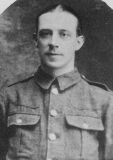
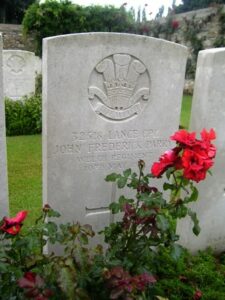
Archie Potts, Corporal, 18734, Welsh Regiment. Archie was born in 1896, the son of John and Anne Jane Potts, of Isledon, Trinity Place, Aberystwyth. He enlisted at Aberystwyth into the 15th Battalion, Welsh Regiment, which was known as the Carmarthen Pals battalion, attached to 114 Brigade, 38th (Welsh) Division. On 2 December 1915 the battalion moved to France, and the entire Division moved to the Fleurbaix sector, where it was initiated into trench warfare. During June 1916 the Division marched south to the Somme, and on 7 July 1916 attacked Mametz Wood. The initial attack failed, and it was three days later, on 10 July, that a fresh attack was mounted. After two days of heavy hand to hand fighting within the wood, the Germans withdrew, and the battered Welshmen moved via Hébuterne to Boesinghe, on the Yser Canal, where it remained until launching its attack on Pilckem Ridge on 31 July 1917. Archie was killed in action at Pilckem Ridge on 31 July 1917. He was 20 years old and is commemorated on the Ypres (Menin Gate) Memorial, Belgium.
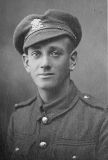
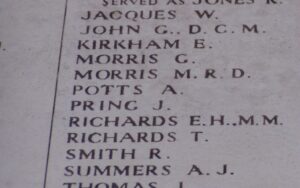
John Joseph Price, Private, 77449, Royal Welsh Fusiliers. John was born at Aberystwyth in 1900, the son of John and Sarah Price. He resided at Lamphey prior to the war, and enlisted at Carmarthen into the army. John was sent to France at some time during 1918, where he joined the 16th Battalion, Royal Welsh Fusiliers. The battalion was attached to 113 Brigade, 38th (Welsh) Division, and John probably joined them on the Somme, at Aveluy. On 21 August 1918 the Division launched its attack across the River Ancre, and within days captured Thiepval Ridge and Pozières. They then began their drive towards the Hindenburg Line. John was killed in action during the Battle of the Selle, on 22 October 1918. He is buried at Montay Communal Cemetery, France.
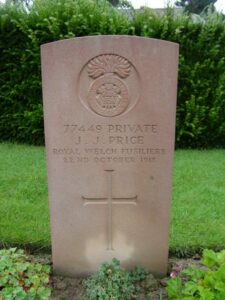
Henry Morgan Richards, Private, 31742, Welsh Regiment. Henry was the son of Morgan and Mary Anne Richards, of 6, Little Dark Gate Street, Aberystwyth. He enlisted at Aberystwyth into the 15th Battalion, Welsh Regiment, which was known as the Carmarthen Pals battalion, attached to 114 Brigade, 38th (Welsh) Division. On 2 December 1915 the battalion moved to France, and the entire Division moved to the Fleurbaix sector, where it was initiated into trench warfare. During June 1916 the Division marched south to the Somme, and on 7 July 1916 attacked Mametz Wood. The initial attack failed, and it was three days later, on 10 July, that a fresh attack was mounted. After two days of heavy hand to hand fighting within the wood, the Germans withdrew, and the battered Welshmen moved via Hébuterne to Boesinghe, on the Yser Canal, where it remained until launching its attack on Pilckem Ridge on 31 July 1917. Henry was killed on 30 July 1917, on the eve of the attack on Pilckem Ridge. He was 39 years old, and is buried in Bard Cottage Cemetery, Belgium.
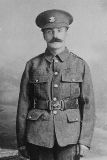
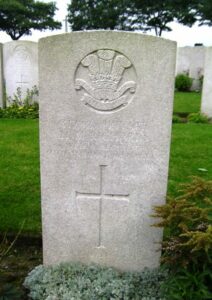
Hugh Owen Rowe, Pioneer, 82545, Royal Engineers. Hugh, who was known locally as Hughie, was born at Aberystwyth in 1896, the son of John Hugh Rowe, musical director of the town band, and Elizabeth Rowe of Glencairn North Road, Aberystwyth. Hughie had played football for Aberystwyth Town FC prior to the war. He enlisted in 1915 into the Royal Engineers, and was posted to France early in 1916, joining the 8th Division Signal Company, Royal Engineers. The 8th Division was on to the Somme in 1916, where they fought at the Battle of Albert. In March 1917 they followed the German Retreat to the Hindenburg Line, and later that year moved to Ypres, fighting at the Battle of Pilckem, and the Battle of Langemarck. In March 1918 the Division was on the southern end of the Somme, and here met the German Offensive head on, at the Battle of St Quentin, desperately fighting a rearguard action over the coming days, before being withdrawn from the line to rest. Hughie took ill with influenza during this period, and was evacuated to Etaples where he was hospitalised. Hughie was 22 years old when he died of influenza at the 51st General Hospital at Etaples on 5 May 1918. He is buried at Étaples Military Cemetery, France.
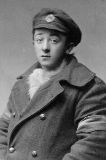
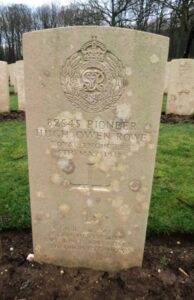
Evan David Rowlands, Lance Corporal, 19964, Royal Welsh Fusiliers. Evan was born in 1889, the son of Evan and Anne Rowlands, of 13, Bridge Street, Aberystwyth. He enlisted in 1914 into the Welsh Regiment, but was transferred to the 16th Battalion Royal Welsh Fusiliers. The battalion was attached to 113 Brigade, 38th (Welsh) Division, and landed in France on 2 December 1915, and had spent their first winter in the trenches near Armentieres. In June they marched south to the Somme, where they were tasked with the capture of Mametz Wood. The attack on the wood began on 7 July, but met with fierce resistance, and it took until 14 July to totally clear the wood. The Division suffered terrible casualties at Mametz, and were taken out of the line, and moved to Ypres to rebuild. Here they fought at the Battle of Pilckem Ridge, and the Battle of Langemarck. They then moved to Armentieres, where they remained from September 1917 until March 1918 when the German Spring Offensive was launched. The British had been over-run on the Somme, and in April the Division was moved South, taking up positions North of Albert, from where they weathered the storm of the coming months, until the war turned during the Battle of Amiens, on 8 August 1918. The Germans had now lost the upper hand, and the British regained the lost ground on the Somme after an attack which began on 21 August, with the 38th Welsh in the midst of the attack during the Battle of Albert, and then moving east, where they fought at the Battle of Bapaume. Then the move began towards the mighty Hindenburg Line, and the Division carried on with their march east, fighting at the Battle of Havrincourt, and the Battle of Épehy. A short rest period ensued, during which time the Canal du Nord was breached, so opening a passage through the Hindenburg Line. Evan was gassed during the fighting around the Canal du Nord, and was evacuated to Etaples for treatment. He then contracted influenza and pneumonia, and died at Etaples on 31 October 1918, aged 29. He is buried at Étaples Military Cemetery, France.
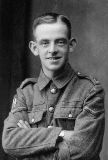
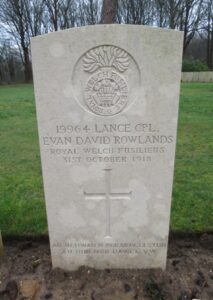
Thomas Gwynne Silcock, 1037DA, Royal Naval Reserve. Thomas was born in 1897, the son of James and Elizabeth Silcock, of 12, Penmaesglas Street, Aberystwyth. He had enlisted on 27 January 1916 into the Royal Naval Reserve and had served for a while during the war as a deck hand on the minesweeper HMS Sabrina. He was discharged later that year after having contracted a disease. Thomas was 23 years old when he died on 9 November 1918, and was buried in Aberystwyth Cemetery with full military honours. Thomas is not commemorated by the CWGC as his death was not due to his military service.
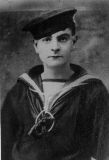
James Stephens, Private, 84505, Royal Army Medical Corps. James was the son of William and Mary Elizabeth Stephens, of 3, Spring Gardens, Trefechan, Aberystwyth. He enlisted at Aberystwyth on 19 September 1916 into the Royal Army Medical Corps, and was posted to France on 4 April 1918, joining the 58th Field Ambulance, Royal Army Medical Corps, which was attached to the 19th (Western) Division. The Division had just moved to positions near Messines to rebuild after being decimated on the Somme the in March, following its desperate and gallant defensive action at Bapaume. James had only been at the front a few days, when he was killed in action on 18 April 1918 while doing good work as a stretcher-bearer. He is buried in Lijssenthoek Military Cemetery, Belgium. His father William had died just after enlisting in 1915, and his brother William Thomas Stephens had been killed at Ypres in 1917.
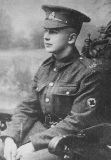
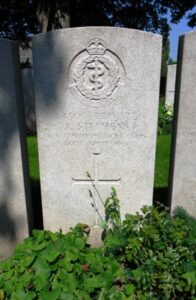
William Thomas Stephens, Private, 27352, South Wales Borderers. William was the son of William Owen Stephens and Mary Elizabeth Stephens, of 3, Spring Gardens, Trefechan Aberystwyth. Formerly employed by the National Library, he enlisted at Aberystwyth into the South Wales Borderers. William was posted to France in 1916, joining the 2nd Battalion, South Wales Borderers, which was attached to 87 Brigade, 29th Division. The Division had fought at Gallipoli, before being evacuated to Egypt, moving to France in March 1916. The Division took part in its first major action in France during the 1916 Somme Offensive, and fought at the Battles of Albert and Le Transloy, suffering heavy casualties. In the Spring of 1917 they fought at the Battle of the Scarpe, which was part of the Arras Offensive, and then moved further north to Ypres. Here they fought at the Battle of Langemarck. William was killed in action here during the Battalions attack on Langemarck on 16 August 1917, aged 20. He is commemorated on the Tyne Cot Memorial, Belgium. His father William Owen Stephens had died soon after enlisting, and his brother, James was killed in April 1918.
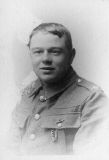
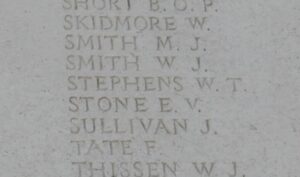
Fred Thomas. This man cannot presently be identified.
Harold Sylvanus Thomas, Private, 9909, Honourable Artillery Company. Harold was born at Aberystwyth, the Son of John and Margaret Thomas, of Granville, 1, North Parade. He resided in St. Clears at the outbreak of war, where he worked as a Bank Clerk, and enlisted at Carmarthen on 8 December 1915, and the following month was at Armoury House, London, after being posted to the 2nd Battalion, Honourable Artillery Company. The Battalion was attached to 22 Brigade, 7th Division, and on 3 October 1916 landed at Havre, taking part in the advance to the Hindenburg Line in early 1917 after the German withdrawal. In Spring 1917 the Battle of Arras was launched, and Harold was killed in action on 15 May 1917, during the Battle of Bullecourt, after being shot in the head. He was 25 years old, and is commemorated on the Arras Memorial, France.
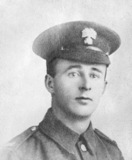
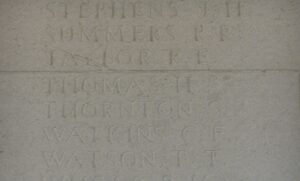
Joseph Thomas, DCM, MM, Sergeant, 3238, Royal Scots. Joseph was born in 1888, the Son of John and Elizabeth Thomas, of Llanbadarn. He married Christina Yeardly prior to the war, and lived with her at Cardigan. Joseph was an army reservist, and at the outbreak of war rejoined the 2nd Battalion, Royal Scots at Fife. He landed in France with the battalion on 23 October 1914, attached to 8 Brigade, 3rd Division. The Division moved to the Belgian frontier, and fought during the opening Battle of Mons, and in the retreat, to the Marne, where the German Offensive was stopped. They followed the German withdrawal to the Aisne, where they met them in battle, and stopped the advance on Paris. The Division then moved north to Flanders, and took part in the Battle of La Bassée, and at the Battle of Messines, which were a prelude to the First Battle of Ypres. They took part in the famous Christmas Truce on 25 December 1914 and remained at Ypres throughout the winter. In 1915 the Division saw action at Bellewaarde and Hooge, and took part in the Second attack on Bellewaarde, and in 1916 fought at the Actions of the Bluff, and at the St Eloi Craters. Joseph was awarded the Distinguished Conduct Medal for his gallantry at Ypres. The citation in the London Gazette read; ‘For conspicuous gallantry when leading his section in a bombing attack in face of heavy bomb and rifle fire. He set a splendid example by his own personal courage, and held on till the position was consolidated.’ He took ill during this time, and returned to Llanbadarn to recuperate. He was back in France on 13 April 1916, whereupon he joined the 12th Battalion, Royal Scots, which was attached to 27 Brigade, 9th (Scottish) Division. Joseph saw heavy fighting on the Somme that year. By April 1917 the Division had moved to Arras, and it was there, during the Battle of the Scarpe, that Joseph was killed, on 12 April 1917. He was 29 years old, and is buried at Brown’s Copse Cemetery, Rouex, France. His widow Christina later remarried, and resided with her new husband at Grangehill Farm, Kinghorn, Fife.
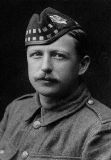
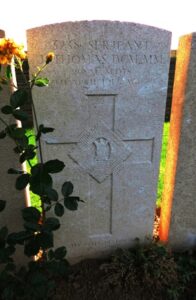
William Williams, Private, 4931, Australian Imperial Forces. William was the son of Daniel and Elizabeth Williams of 1, Williams Street, Aberystwyth. William was a sailor, and had emigrated to Australia at the age of fourteen, along with his brother, and prior to the war had married, residing with his wife, Sarah Ann Williams, at Freemantle, Western Australia. William enlisted at Blackboy Hill on 28 February 1916 into the 11th Battalion, Australian Infantry, and on 1 April 1916 left Fremantle aboard HMAT Ulysses, bound for Egypt. At Tel-El-Kabir William’s group of reinforcements joined with veterans from Gallipoli to form the 51st Battalion, Australian Imperial Force, which became attached to the 13th Brigade, 4th Australian Division. Arriving in France on 12 June 1916, the 51st Battalion moved into the front line, and fought in its first major battle at Mouquet Farm in August and September 1916, suffering almost 30 percent casualties. The battalion saw out the rest of the year, alternating between front-line duty, and training and labouring behind the line near Flers during the bleak winter of 1916-17. Early in 1917, the battalion followed the German retreat to the Hindenburg Line, and on 2 April 1917 it attacked at Noreuil. Later in the year, the AIF moved to Ypres, and the 4th Division fought in the battle of Messines between 7 and 12 June, and the battle of Polygon Wood between 26 and 27 September. William was killed in action at Polygon Wood on 29 September 1917. His grave was never located, so William is commemorated on the Ypres (Menin Gate) Memorial, Belgium.
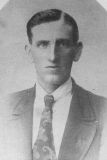
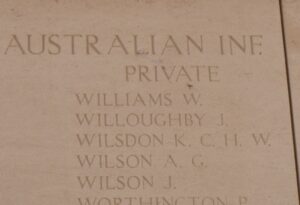
Ernest Worthington, Private, 22723, Welsh Regiment. Ernest was born on 11 December 1897, the son of Ronald and Annie Worthington, of More Lane, Aberystwyth. On his 17th birthday, on 11 December 1914, Ernest enlisted at Aberystwyth into the 9th Battalion, Welsh Regiment, which was attached to 58 Brigade, 19th (Western) Division. The Division moved to France during July 1915, and moved to positions near Loos, where it took part in the opening attack of the Battle of Loos on 25 September 1915. The following year the Division moved to the Somme, where it took part in the second wave of the attack on Ovillers-La Boisselle on 1 July, capturing the village at heavy cost. It then fought through the Somme Battles of Pozières and the Ancre in 1916. In 1917 the Division moved north to Ypres, taking part in the Battle of Messines. Ernest had by now been wounded in action three times, but was unlucky at Messines, being killed in action on 7 August 1917, aged 19. He was buried in Oosttaverne Wood Cemetery, Belgium.
